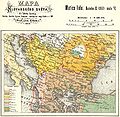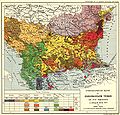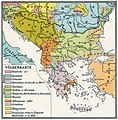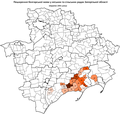Bulgarians: Difference between revisions
m Replace magic links with templates per local RfC and MediaWiki RfC |
Rescuing 1 sources and tagging 0 as dead. #IABot (v1.6.1) (Balon Greyjoy) |
||
| Line 261: | Line 261: | ||
===Sport=== |
===Sport=== |
||
{{main article|Sport in Bulgaria|Football in Bulgaria}}{{multiple image|align=left |
{{main article|Sport in Bulgaria|Football in Bulgaria}}{{multiple image|align=left |
||
|image1 = Hristo stoichkov-2010 (crop).jpg|width1=92|caption1= [[Hristo Stoichkov]], awarded the [[Ballon d'Or (1956–2009)|Golden Ball]] and regarded as one of the best footballers by Barcelona.<ref>{{cite web|url=http://www.fcbarcelona.com/web/english/club/historia/jugadors_de_llegenda/stoichkov.html |title=HRISTO STOICHKOV | FCBarcelona.cat |publisher=Fcbarcelona.com |date= |accessdate=2015-02-11}}</ref> |
|image1 = Hristo stoichkov-2010 (crop).jpg|width1=92|caption1= [[Hristo Stoichkov]], awarded the [[Ballon d'Or (1956–2009)|Golden Ball]] and regarded as one of the best footballers by Barcelona.<ref>{{cite web |url=http://www.fcbarcelona.com/web/english/club/historia/jugadors_de_llegenda/stoichkov.html |title=HRISTO STOICHKOV | FCBarcelona.cat |publisher=Fcbarcelona.com |date= |accessdate=2015-02-11 |deadurl=yes |archiveurl=https://archive.is/20130103000543/http://www.fcbarcelona.com/web/english/club/historia/jugadors_de_llegenda/stoichkov.html |archivedate=3 January 2013 |df=dmy-all }}</ref> |
||
|image2 = Veselin Topalov Sofia Airport 24.10.2005.pic-01.jpg|width2=121|caption2=[[Veselin Topalov]], the 21st [[World Chess Champion]]. |
|image2 = Veselin Topalov Sofia Airport 24.10.2005.pic-01.jpg|width2=121|caption2=[[Veselin Topalov]], the 21st [[World Chess Champion]]. |
||
|image3 = |width3=130|caption3=[[André the Giant|André Roussimoff]], the most famous [[World Wrestling Federation|WWF]] wrestler.<ref>{{cite book|url=https://books.google.com/books?id=00XoU40tLO8C&pg=PA66 |title=Tributes II: Remembering More of the World's Greatest Professional Wrestlers |author1=Dave Meltzer |author2=Bret Hart |website=Books.google.com |date= 2004-01|accessdate=2016-11-22|isbn=9781582618173 }}</ref> |
|image3 = |width3=130|caption3=[[André the Giant|André Roussimoff]], the most famous [[World Wrestling Federation|WWF]] wrestler.<ref>{{cite book|url=https://books.google.com/books?id=00XoU40tLO8C&pg=PA66 |title=Tributes II: Remembering More of the World's Greatest Professional Wrestlers |author1=Dave Meltzer |author2=Bret Hart |website=Books.google.com |date= 2004-01|accessdate=2016-11-22|isbn=9781582618173 }}</ref> |
||
Revision as of 18:08, 6 December 2017
| Total population | |
|---|---|
| c. 9–11.3 million 7.3 million Bulgaria nationals Catholic and Protestant minorities | |
| Related ethnic groups | |
| Other South Slavs, especially Macedonians[41] | |
^ a: The 2011 census figure was 5,664,624.[42] The question on ethnicity was voluntarily and 10% of the population did not declare any ethnicity,[43] thus the figure is considered insufficient and ethnic Bulgarians are estimated at around 6 million.[44] ^ b: Estimates[45][46] of the number of Pomaks whom most scholars categorize as Bulgarians[47][48] |
Bulgarians (
Citizenship
According to the Art.25 (1) of Constitution of Bulgaria, a Bulgarian citizen shall be anyone born to at least one parent holding a Bulgarian citizenship, or born on the territory of the Republic of Bulgaria, should they not be entitled to any other citizenship by virtue of origin. Bulgarian citizenship shall further be acquirable through naturalization.[49] About 77% of Bulgaria's population identified themselves as Bulgarian in 2011 Bulgarian census.[50]
Ethnogenesis
The population of Bulgaria descend from peoples with different origins and numbers. They became assimilated by the Slavic settlers in the First Bulgarian Empire, three of which left something remarkable.
- the ancient pre-Slavic indigenous peoples, notably Thracians, from whom cultural and ethnic elements were taken;[51][52]
- the Early Slavs from whom the language was inherited;
- the Bulgars from whom the ethnonym and the early statehood were inherited.[53][54]
From the indigenous
The Early Slavs emerged from their original homeland in the early 6th century, and spread to most of the eastern
The
During the Early Byzantine Era, the Roman provincials in Scythia Minor and Moesia Secunda were already engaged in economic and social exchange with the 'barbarians' north of the
Bulgarian ethnogenetic conception
The Bulgarians are usually regarded as part of the
Genetic origins
According to a triple –
History
| Part of a series on |
| Bulgarians Българи |
|---|
 |
| Culture |
| By country |
| Subgroups |
| Religion |
| Language |
| Other |

The First Bulgarian Empire was founded in 681. After the adoption of
In 1018 Bulgaria lost its independence and remained a Byzantine subject until 1185, when the
Some Bulgarians supported the Russian Army when they crossed the Danube in the middle of the 18th century. Russia worked to convince them to settle in areas recently conquered by it, especially in Bessarabia. As a consequence, many Bulgarian colonists settled there, and later they formed two military regiments, as part of the Russian military colonization of the area in 1759–1763.[112]
Bulgarian national movement
During the
It was not until the 1850s when the Bulgarians initiated a purposeful struggle against the
Eastern Rumelia was annexed to Bulgaria in 1885 through bloodless revolution. During the early 1890s, two pro-Bulgarian revolutionary organizations were founded: the
In the early 20th century the control over Macedonia became a key point of contention between Bulgaria, Greece, and
Demographics
Most Bulgarians live in
Related ethnic groups
Until the early 20th century,
Bulgarians are considered most closely related to the neighbouring Macedonians; indeed it is sometimes said there is no discernible ethnic difference between them.
Culture
The Bulgarian culture has largely the product of influence of incoming cultures and is now going through westernization, especially the cuisine.
Language
Bulgarians speak a
Bulgarian demonstrates some linguistic developments that set it apart from other Slavic languages shared with
The Bulgarian language is spoken by the majority of the Bulgarian diaspora, but less so by the descendants of earlier emigrants to the U.S., Canada, Argentina and Brazil.
Bulgarian linguists consider the officialized Macedonian language (since 1944) a local variation of Bulgarian, just as most ethnographers and linguists until the early 20th century considered the local Slavic speech in the Macedonian region. The president of Bulgaria Zhelyu Zhelev, declined to recognize Macedonian as a separate language when the Republic of Macedonia became a new independent state. The Bulgarian language is written in the Cyrillic script.
Cyrillic alphabet
In the first half of the 10th century, the
Name system
There are several different layers of Bulgarian names. The vast majority of them have either Christian (names like Lazar,
Most Bulgarian male surnames have an -ov
Other common Bulgarian male surnames have the -ev
Another typical Bulgarian surname suffix, though less common, is -ski. This surname ending also gets an –a when the bearer of the name is female (Smirnenski becomes Smirnenska). The plural form of the surname suffix -ski is still -ski, e.g. the Smirnenski family (Bulgarian: Смирненски).
The ending –in (female -ina) also appears rarely. It used to be given to the child of an unmarried woman (for example the son of Kuna will get the surname Kunin and the son of Gana – Ganin). The surname suffix -ich can be found only occasionally, primarily among the
Religion
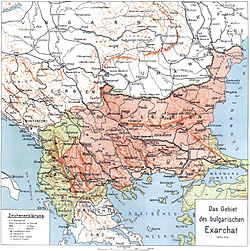
Most Bulgarians are at least nominally members of the
nowadays hold allegiance to the respective national Orthodox churches.Despite the position of the Bulgarian Orthodox Church as a unifying symbol for all Bulgarians, small groups of Bulgarians have converted to other faiths through the course of time. During Ottoman rule, a substantial number of Bulgarians converted to Islam, forming the community of the
Art and science
Boris Christoff, Nicolai Ghiaurov, Raina Kabaivanska and Ghena Dimitrova made a precious contribution to opera singing with Ghiaurov and Christoff being two of the greatest bassos in the post-war period. The name of the harpist-Anna-Maria Ravnopolska-Dean is one of the best-known harpists today. Bulgarians have made valuable contributions to world culture in modern times as well.
Bulgarians in the diaspora have also been active. American scientists and inventors of Bulgarian descent include
Cuisine

Famous for its rich salads required at every meal, Bulgarian cuisine is also noted for the diversity and quality of
Most Bulgarian dishes are oven baked, steamed, or in the form of stew. Deep-frying is not very typical, but grilling—especially different kinds of meats—is very common. Pork meat is the most common meat in the Bulgarian cuisine. Oriental dishes do exist in Bulgarian cuisine with most common being moussaka, gyuvetch, and baklava. A very popular ingredient in Bulgarian cuisine is the Bulgarian white brine cheese called "sirene" (сирене). It is the main ingredient in many salads, as well as in a variety of pastries. Fish and chicken are widely eaten and while beef is less common as most cattle are bred for milk production rather than meat, veal is a natural byproduct of this process and it is found in many popular recipes. Bulgaria is a net exporter of lamb and its own consumption of the meat is prevalent during its production time in spring.[143] Bread and salt tradition in context of welcoming, which is spread in Balto-Slavs, is the usual welcoming of strangers and politicians.
Folk beliefs and customs


Bulgarians may celebrate Saint Theodore's Day with horse racings. At Christmas Eve a Pogača with fortunes is cooked, which are afterwards put under the pillow. At Easter the first egg is painted red and is kept for a whole year. On the Baptism of Jesus a competition to catch the cross in the river is held and is believed the sky is "opened" and any wish will be fulfilled.
Bulgarians as
Bulgarian mythology and fairy tales are mainly about forest figures, such as the dragon
Despite eastern Ottoman influence is obvious in areas such as cuisine and music, Bulgarian folk beliefs and mythology seem to lack analogies with
Folk dress and music

The Bulgarian folk costumes feature long white robes, usually with red embrdoiery and ornaments derived from the Slavic Rachenik. The Bulgarian folk costume is considered to be mainly derived from the dress of the
Folk songs are most often about the nymphs from Bulgarian and
Valya Balkanska is a folk singer thanks to whom the Bulgarian speech in her song "Izlel ye Delyo Haydutin" will be played in the Outer space for at least 60,000 years more as part of the Voyager Golden Record selection of music included in the two Voyager spacecraft launched in 1977.
Sport
As for most European peoples,
In the beginning of the 20th century Bulgaria was famous for two of the best wrestlers in the world –
Symbols
The national symbols of the Bulgarians are the
The national flag of Bulgaria is a rectangle with three colours: white, green, and red, positioned horizontally top to bottom. The colour fields are of same form and equal size. It is generally known that the white represents – the sky, the green – the forest and nature and the red – the blood of the people, referencing the strong bond of the nation through all the wars and revolutions that have shaken the country in the past. The
Both the Bulgarian flag and the Coat of Arms are also used as symbols of various Bulgarian organisations, political parties and institutions.
The horse of the
Maps
-
Ethnic map of European Turkey, Guillaume Lejean (1861), praised by Serbian authors
-
Мар of the Slavic World by Jos. Erban, 1868
-
Henry Wilkinson's map from 1876
-
Ethnic map of European Turkey in 1877, by Austro-Hungarian Consul Karl Sax
-
Peoples at the Balkan Peninsula, Andrees Allgemeiner Handatlas, 1881,
-
Hungarian ethnic map of Europe, 1897
-
Map of A. Scobel, Andrees Allgemeiner Handatlas, 1908
-
Distribution of the Balkan peoples in 1911, Encyclopædia Britannica
-
Ethnic groups in the Balkans and Asia Minor byWilliam R. Shepherd, 1911
-
Distribution European peoples in 1914 according to L. Ravenstein
-
Swiss Ethnographic map of Europe published in 1918 by Juozas Gabrys
-
Percentage of Pomaks by first language according to the 1965 Census excluding Bulgarian language
-
Distribution of Bulgarians inOdessa Oblast, Ukraine according to the 2001 census
-
Distribution of Bulgarians by first language inZaporizhia Oblast, Ukraine according to the 2001 census
-
Distribution of predominant ethnic groups in Bulgaria according to the 2011 census
-
Distribution of Bulgarians in Romania according to the 2002 census
-
Distribution of Bulgarians in Moldova according to the 2004 census
See also
- Macedonians (Bulgarians)
- Macedonians (ethnic group)
- Thracian Bulgarians
References
- ^ "Native Peoples of the World". google.bg.
- ^ a b "Ethnic Groups of Europe: An Encyclopedia". google.bg.
- ^ "On the Margins of Nations". google.bg.
- ^ a b "Брой на българите в чужбина по данни от МВнР по ЗДОИ, 2011" (in Bulgarian). EuroChicago.com.
- ^ "Ukrainian 2001 census". ukrcensus.gov.ua. Retrieved 28 April 2008.
- ^ "Bulgarians in Ukraine". Bulgarian Parliament. Retrieved 21 October 2015. Template:Bg icon
- ^ "Bevölkerung und Erwerbstätigkeit - Ausländische Bevölkerung, Ergebnisse des Ausländerzentralregisters (2017)" (PDF).
- ^ a b "Италианските българи" (in Bulgarian). 24 Chasa.
- ^ INE 2016
- )
- ^ "TOTAL ANCESTRY REPORTED : Universe: Total ancestry categories tallied for people with one or more ancestry categories reported more information : 2011-2013 American Community Survey 3-Year Estimates". Factfinder.census.gov. Retrieved 22 November 2016.
- )
- ^ http://www.statistica.md/ (30 September 2009). "National Bureau of Statistics // Population Census 2004". Statistica.md. Retrieved 22 November 2016.
{{cite web}}: External link in|author= - ^ "Ministry of Foreign Affairs of Bulgaria – Bulgarians in Argentina". Mfa.bg (in Bulgarian). Retrieved 29 April 2008.
- ^ "UK Migration Statistics Quarterly 2014 – Bulgarians in the UK". Ons.gov.uk. Retrieved 22 November 2016.
- )
- ^ De acordo com dados do Instituto Brasileiro de Geografia e Estatística (IBGE), cerca de 62.000 brasileiros declararam possuir ascendência búlgara no ano de 2006, o que faz com que o país abrigue a nona maior colônia búlgara do mundo.
- ^ "bTV – estimate for Bulgarians in Brazil" (in Bulgarian). btv.bg.
- ^ DEMOSTAT
- ^ "Demo ISTAT". ISTAT. Retrieved 15 January 2016.
- ^ "2011 National Household Survey: Data tables". Statistics Canada. Retrieved 11 February 2014.
- ^ "Migration from and towards Bulgaria 1989–2011". p. 39.
- ^ Russia 2010 census Template:Ru icon
- ^ STATISTIK AUSTRIA. "Bevölkerung nach Staatsangehörigkeit und Geburtsland". statistik.at.
- ^ "CBS StatLine - Bevolking; generatie, geslacht, leeftijd en herkomstgroepering, 1 januari". cbs.nl.
- ^ "Cypriot 2011 census". cystat.gov.cy.
- ^ "Serbian 2011 census" (PDF). Statistical Office of the Republic of Serbia. Retrieved 25 December 2012.
- ^ "Ministry of Foreign Affairs of Bulgaria – Bulgarians in South Africa" (in Bulgarian). mfa.bg. Retrieved 8 February 2011.
- ^ "Population par nationalité, sexe, groupe et classe d'âges au 1er janvier 2010". fgov.be.
- ^ https://www.czso.cz/documents/11292/27914491/1612_c01t14.pdf/4bbedd77-c239-48cd-bf5a-7a43f6dbf71b?version=1.0
- ^ "Ministry of Foreign Affairs of Bulgaria – Bulgarians in Poland" (in Bulgarian). mfa.bg.
- ^ "Utrikes födda efter födelseland, kön och år". www.scb.se. Statistiska Centralbyrån. Retrieved 25 May 2017.
- ^ "Population and elections - StatBank Denmark - data and statistics". statistikbanken.dk.
- ^ "National Institute of Statistics of Portugal – Foreigners in 2013" (PDF) (in Portuguese). sefstat.sef.pt. Retrieved 16 April 2011.
- ^ "Bulgaria's State Agency for Bulgarians Abroad – Study about the number of Bulgarian immigrants as of 03.2011". Aba.government.bg (in Bulgarian). Retrieved 22 November 2016.
- ^ "Romanian 2011 census" (XLS) (in Romanian). edrc.ro.
- ^ "Kazakh 1999 census".
{{cite web}}: Missing or empty|url=(help) - ^ "UAE" (in Bulgarian).
- ^ "Australian 2011 census" (PDF). abs.gov.au.
- ^ [1][dead link]
- ^ ISBN 9780203403747. Retrieved 13 November 2011.
- ^ "Bulgarian 2011 census" (PDF) (in Bulgarian). nsi.bg. p. 25. Retrieved 15 October 2012.
- ^ "EPC 2014". Epc2014.princeton.edu. Retrieved 30 August 2015.
- ^ Свободно време (27 July 2011). "Експерти по демография оспориха преброяването | Dnes.bg Новини". Dnes.bg. Retrieved 30 August 2015.
- ISBN 978-1-55671-159-6. Retrieved 14 June 2016.
- ^ "Türkiye'deki Kürtlerin sayısı!" (in Turkish). 6 June 2008. Retrieved 17 August 2010.
- ISBN 9780739107577.
Most scholars categorize Pomaks as "Slav Bulgarians...
- ^ Poulton, Hugh; Committee, Minnesota Lawyers International Human Rights. Minorities in the Balkans. Minority Rights Group. p. 7.
...'Pomaks', are a religious minority. They are Slav Bulgarians who speak Bulgarian...
- ^ "Народно събрание на Република България - Конституция". Parliament.bg. Retrieved 22 November 2016.
- ^ http://www.nsi.bg/sites/default/files/files/pressreleases/Census2011final.pdf
- ^ ISBN 0-89158-530-3, p. 27.
- ^ PMID 26332464.)
{{cite journal}}: CS1 maint: unflagged free DOI (link - ^ ENCYCLOPÆDIA BRITANNICA, Bulgar People, https://www.britannica.com/topic/Bulgar
- ^ ISBN 0472081497.
- ^ "The so-called Bulgar inscriptions are, with few exceptions, written in Greek rather than in Turkic runes; they mention officials with late antique titles, and use late Antique terminology and indictional dating. Contemporary Byzantine inscriptions are not obviously similar, implying that this (Bulgar) epigraphic habit was not imported from Constantinople but was a local Bulgar development, or rather, it was an indigenous 'Roman' inheritance." Nicopolis ad Istrium: Backward and Balkan, by M Whittow.
- ISSN 0024-5089. 1992 LITUANUS Foundation, Inc.
- ^ Bulgarian historical review, Publishing House of the Bulgarian Academy of Sciences, pp. 53
- ^ The Oxford Encyclopedia of Ancient Greece and Rome, 7th edition, pp. 57
- ^ Ethnic Continuity in the Carpatho-Danubian Area, Elemér Illyés
- )
- ISBN 1853024856, pp. 18-19.
- ISBN 3111568873, pp. 9-10; 71.
- ^ Liviu Petculescu. "The Roman Army as a Factor of Romanisation in the North-Eastern Part of Moesia Inferior" (PDF). Pontos.dk. Retrieved 30 August 2015.
- ^ "Landscapes of Change - Chapter 8". google.com.au.
- ^ "War and Warfare in Late Antiquity (2 vol. set)". google.com.au. p. 781.
- ^ Sofia - 127 years capital. Sofia Municipality
- ^ Encyclopedia of Indo-European Culture, by Douglas Q. Adams, pp. 576
- ISBN 0-472-08149-7, p. 31
- ^ ISBN 1-4039-6417-3
- ^ Образуване на българската държава. проф. Петър Петров (Издателство Наука и изкуство, София, 1981)
- ^ "Образуване на българската народност.проф. Димитър Ангелов (Издателство Наука и изкуство, "Векове", София, 1971)". Kroraina.com. Retrieved 13 November 2011.
- ^ Runciman, Steven. 1930. A history of the First Bulgarian Empire. London: G. Bell & Sons.: §I.1
- ^ Vassil Karloukovski. "История на българската държава през средните векове Васил Н. Златарски (I изд. София 1918; II изд., Наука и изкуство, София 1970, под ред. на проф. Петър Хр. Петров)". Kroraina.com. Retrieved 13 November 2011.
- ^ Rasho Rashev, Die Protobulgaren im 5.-7. Jahrhundert, Orbel, Sofia, 2005. (in Bulgarian, German summary)
- JSTOR 23658601.
- ISBN 9780312299132.
- ^ "The Slavs of the Mid-Danube basin and the Bulgarian Expansion in the first half of the Ninth Century" (PDF), Zbornik Radova Vizantološkog Instituta, DOI Serbia, 2010, retrieved 11 August 2013
- ^ Steven Runciman, A history of the First Bulgarian Empire, page 28
- ISBN 9004125248. Retrieved 11 February 2015.
- ^ Florin Curta. Horsemen in forts or peasants in villages? Remarks on the archaeology of warfare in the 6th to 7th century Balkansmore; 2013
- ISBN 0521616379, p. 13.
- ISBN 9780521291262. Retrieved 13 November 2011.
- ^ "The Formation of the Bulgarian Nation, Academician Dimitŭr Simeonov Angelov, Summary, Sofia-Press, 1978". Kroraina.com. Retrieved 13 November 2011.
- ^ L. Ivanov. Essential History of Bulgaria in Seven Pages. Sofia, 2007.
- )
- ISBN 978-0-472-08149-3.
- ISBN 978-963-7326-60-8.
- ISBN 9979992212, p. 194.
- ISBN 978-3-319-45108-4.
- ^ "Differentiation in Entanglement: Debates on Antiquity, Ethnogenesis and Identity in Nineteenth-Century Bulgaria", in Klaniczay, Gábor and Werner, Michael (eds.), Multiple Antiquities - Multiple Modernities. Ancient Histories in Nineteenth Century European Cultures. Frankfurt - Chicago: Universtiy of Chicago Press, 2011, 213-246.
- ISBN 9639776289.
- ISBN 0230583474, p. 285.
- ^ Detrez, Raymond (2005). Developing Cultural Identity in the Balkans: Convergence Vs. Divergence. Peter Lang. p. 29.
- ISBN 1442241802, pp. 189-190.
- ISBN 9789004290365, pp 10-117.
- ISBN 9780521815390. Retrieved 11 February 2015.
- ISBN 978-1-85065-534-3.
- ISBN 9989756074. Retrieved 11 February 2015.
- ISBN 9780719060953. Retrieved 11 February 2015.
- ISBN 0472081497. Retrieved 11 February 2015 – via Books.google.bg.
- ISBN 9780295800646. Retrieved 11 February 2015.
- ^ "Bulgaria – Ottoman rule". Encyclopædia Britannica Online. Retrieved 21 December 2011.
With the capture of a rump Bulgarian kingdom centred at Bdin (Vidin) in 1396, the last remnant of Bulgarian independence disappeared. ... The Bulgarian nobility was destroyed—its members either perished, fled, or accepted Islam and Turkicization—and the peasantry was enserfed to Turkish masters.
- ISBN 9004135766. Retrieved 11 February 2015.
- ISBN 9789052013749. Retrieved 11 February 2015.
- ISBN 9004121013. Retrieved 11 February 2015.
- ISBN 0195374924, p. 276: "There were almost no remnants of a Bulgarian ethnic identity; the population defined itself as Christians, according to the Ottoman system of millets, that is, communities of religious beliefs. The first attempts to define a Bulgarian ethnicity started at the beginning of the 19th century."
- ISBN 0313319499.
- )
- )
- ISBN 9788884924643. Retrieved 11 February 2015.
- )
- ^ Milchev, Vladimir (2002). "Два хусарски полка с българско участие в системата на държавната военна колонизация в Южна Украйна (1759-1762/63 г.)" [Two Hussar Regiments with Bulgarian Participation in the System of the State Military Colonization in Southern Ukraine (1759-1762/63)]. Исторически преглед (in Bulgarian) (5–6): 154–65.
- ISBN 9780295803609. Retrieved 11 February 2015.
- ISBN 3825813878.
- ISBN 0847698092, p. 236.
- ISBN 1-85065-492-1.
- ISBN 0-691-04356-6.
- ISBN 0-8014-8736-6.
The key fact about Macedonian nationalism is that it is new: in the early twentieth century, Macedonian villagers defined their identity religiously—they were either "Bulgarian," "Serbian," or "Greek" depending on the affiliation of the village priest. While Bulgarian was most common affiliation then, mistreatment by occupying Bulgarian troops during WWII cured most Macedonians from their pro-Bulgarian sympathies, leaving them embracing the new Macedonian identity promoted by the Tito regime after the war.
- ^ "Experts for Census 2011" (in Bulgarian).
- ^ a b "Bulgarian 2001 census" (in Bulgarian). nsi.bg. Retrieved 21 July 2011.
- ^ "Chairman of Bulgaria's State Agency for Bulgarians Abroad – 3–4 million Bulgarians abroad in 2009" (in Bulgarian). 2009. Retrieved 7 March 2011.
- ^ "Божидар Димитров преброи 4 млн. българи зад граница" (in Bulgarian). 2010. Archived from the original on 14 July 2011. Retrieved 7 March 2011.
- ^ dans la Macédoine - Cousinéry, Esprit Marie. Voyage dans la Macédoine: contenant des recherches sur l'histoire, la géographie, les antiquités de ce pays, Paris, 1831, Vol. II, p. 15-17, one of the passages in English – [2], Engin Deniz Tanir, The Mid-Nineteenth century Ottoman Bulgaria from the viewpoints of the French Travelers, A Thesis Submitted to the Graduate School of Social Sciences of Middle East Technical University, 2005, p. 99, 142
- ^ Pulcherius, Recueil des historiens des Croisades. Historiens orientaux. III, p. 331 – a passage in English -http://promacedonia.org/en/ban/nr1.html#4
- ISBN 9781850654926. Retrieved 13 November 2011.
- ISBN 1-85065-238-4, p. 109.
- ^ Felix Philipp Kanitz, (Das Konigreich Serbien und das Serbenvolk von der Romerzeit bis dur Gegenwart, 1904, in two volume) # "In this time (1872) they (the inhabitants of Pirot) did not presume that six years later the often damn Turkish rule in their town will be finished, and at least they did not presume that they will be include in Serbia, because they always feel that they are Bulgarians. ("Србија, земља и становништво од римског доба до краја XIX века", Друга књига, Београд 1986, p. 215)"And today (in the end of the 19th century) among the older generation there are many fondness to Bulgarians, that it led him to collision with Serbian government. Some hesitation can be noticed among the youngs..." ("Србија, земља и становништво од римског доба до краја XIX века", Друга књига, Београд 1986, c. 218; Serbia – its land and inhabitants, Belgrade 1986, p. 218)
- ^ Стойков, Стойко: Българска диалектология, Акад. изд. "Проф. Марин Дринов", 2006
- ^ Girdenis A., Maziulis V. Baltu kalbu divercencine chronologija // Baltistica. T. XXVII (2). - Vilnius, 1994. - P. 9.
- ^ Топоров В.Н. Прусский язык. Словарь. А - D. - М., 1975. - С. 5
- ISBN 9781137048172
- ^ "Social Construction of Identities: Pomaks in Bulgaria, Ali Eminov, JEMIE 6 (2007) 2 © 2007 by European Centre for Minority Issues" (PDF). Retrieved 11 February 2015.
- ^ От Труд онлайн. "Архивът е в процес на прехвърляне – Труд". Trud.bg. Retrieved 22 November 2016.
- ^ [4][dead link]
- )
- )
- ^ "Bulgaria- Eastern Europe's Newest Hot Spot | Offshoring Business Intelligence & Tools | EU Out-Sourcing Specialists Platform | German Market-Entry offshoring Vendor Services". Outsourcingmonitor.eu. 6 August 2006. Retrieved 15 April 2010.
- ^ "Outsourcing to Bulgaria". Archived from the original on 20 June 2010.
- ^ "World's cleverest woman needs a job". theregister.co.uk.
- ^ Independent Newspapers Online (8 November 2004). "The world's 'smartest woman' can't find a job – Back Page | IOL News". IOL.co.za. Retrieved 13 November 2011.
- ^ "Bulgarians uncover the birth of the Universe", dir.bg, 21 December 2007
- ^ "Bulgaria Poultry and Products Meat Market Update". The Poultry Site. 8 May 2006. Retrieved 30 August 2015.
- ^ Колева Т. А. Болгары // Календарные обычаи и обряды в странах зарубежной Европы. Конец XIX — начало XX в. Весенние праздники. — М.: Наука, 1977. — С. 274–295. — 360 с.
- ^ "??" (PDF). Tangrabg.files.wordpress.com. Retrieved 22 November 2016.
- ^ "??" (PDF). Bkks.org. Retrieved 22 November 2016.
- ISBN 954-304-009-5
- ^ История во кратце о болгарском народе словенском
- ^ a b c d e f g h i j k l m n o p q r s t u v w x y "??" (PDF). Mling.ru. Retrieved 22 November 2016.
- ^ "Русалии - древните български обичаи по Коледа". Bgnow.eu. Retrieved 22 November 2016.
- ^ Следи от бита и езика на прабългарите в нашата народна култура, Иван Коев, София, 1971
- ^ ISBN 9781853024856.
The so-called Kapantsi - an ethnographic group living mainly in the Razgrad and Turgovishte, area of north-east Bulgaria - are believed to be descendants of Asparuh's Proto-Bulgars who have maintained at least something of their original heritage...the traditional costumes of Bulgaria are derived mainly from the ancient Slav costumes...Women's costumes fall into four main categories: one-apron, two-apron, sukman and saya. Like men's costumes, these are not intrinsically separate types, but have evolved from the original chemise and apron worn by the early Slavs...Directly descended with little mutation from the dress of the ancient Slavs, the one-apron ...
- ^ "Д. Ангелов, Образуване на българската народност - 4.3". Promacedonia.org. Retrieved 22 November 2016.
- ^ "Ekip7 Разград - Коренните жители на Разград и района – българи, ама не какви да е, а капанци!". Ekip7.bg. 14 September 2015. Retrieved 22 November 2016.
- ^ [5]
- ^ "Символы в орнаментах древних славян". Etnoxata.com.ua. 25 January 2015. Retrieved 22 November 2016.
- ^ В. В. Якжик, Государственный флаг Республики Беларусь, w: Рекомендации по использованию государственной символики в учреждениях образования, page 3.
- ISBN 9781847883988.
Bulgarian women's dress include overgarments that are joined at the shoulders and are considered to have evolved from the sarafan. (the pinafore dress typically worn by women of various Slav nations). This type of garment includes the soukman and the saya and aprons that fasten at the waist that are also attributed to a Slavic origin.
- ^ "??" (PDF). Bkks.org. Retrieved 22 November 2016.
- ^ "HRISTO STOICHKOV | FCBarcelona.cat". Fcbarcelona.com. Archived from the original on 3 January 2013. Retrieved 11 February 2015.
{{cite web}}: Unknown parameter|deadurl=ignored (|url-status=suggested) (help) - ISBN 9781582618173. Retrieved 2016-11-22.)
{{cite book}}:|website=ignored (help); Check date values in:|date=(help
External links
 Media related to People of Bulgaria at Wikimedia Commons
Media related to People of Bulgaria at Wikimedia Commons


